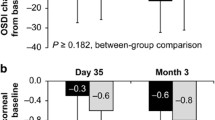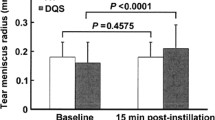Abstract
Background
Dry eye is a common condition, affecting approximately 10–20% of the adult population. Artificial tears are often effective in relieving symptoms in mild and moderate dry eye by replenishing deficient tear volume. Sodium hyaluronate has been proposed as a component in artificial tears, due to its viscoelastic rheology. This paper reports on a study carried out to assess the efficacy of two recently developed eyedrops containing 0.1% and 0.3% sodium hyaluronate (SH) in the treatment of moderate dry eye.
Methods
Thirteen subjects were recruited with moderate dry eye. Forty microlitres of 0.1% SH, 0.3% SH, or 0.9% saline were instilled in both eyes, and the subjects’ symptom intensity and non-invasive break-up time (NIBUT) were measured at 5, 15, 30, 45, and 60 min, and then hourly, until 6 h after drop instillation. This was repeated twice following an interval of 7(±1) days, but with a different treatment so that at the end of the final visit each subject had trialled all products. Drop allocation was randomized and double-masked.
Results
Both symptoms and NIBUT improved with all treatments. These changes were of a larger magnitude and longer duration with the SH containing eyedrops than with saline. SH of 0.3% tended to perform better than 0.1% SH and achieved statistical significance (P=0.04) for NIBUT when considered over the whole 6-h study period.
Conclusions
Sodium hyaluronate of 0.1% and 0.3% reduces symptoms of ocular irritation and lengthens NIBUT in subjects with moderate dry eye more effectively than saline, in terms of peak effect and duration of action.


Similar content being viewed by others
References
Aragona P, Di Stefano G, Ferreri F, Spinella R, Stilo A (2002) Sodium hyaluronate eyedrops of different osmolarity for the treatment of dry eye in Sjogren's syndrome patients. Br J Ophthalmol 86:879–884
Begley CG, Waggoner PJ, Hafner GS, Tokarski T, Meetz RE, Wheeler WH (1991) Effect of rigid gas permeable contact lens wetting solutions on the rabbit corneal epithelium. Optom Vis Sci 68:189–197
Condon PI, McEwen CG, Wright M, Mackintosh G, Prescott RJ, McDonald C (1999) Double blind, randomised, placebo controlled, crossover, multicentre study to determine the efficacy of a 0.1% (w/v) sodium hyaluronate solution (Fermavisc) in the treatment of dry eye syndrome. Br J Ophthalmol 83:1121–1124
Efron N (1998) Grading scales for contact lens complications. Ophthalmic Physiol Opt 18:182–186
Gilbard JP, Carter JB, Sang DN, Refojo MF, Hanninen LA, Kenyon KR (1984) Morphologic effect of hyperosmolarity on rabbit corneal epithelium. Ophthalmology 91:1205–1212
Gomes JA, Amankwah R, Powell-Richards A, Dua HS (2004) Sodium hyaluronate (hyaluronic acid) promotes migration of human corneal epithelial cells in vitro. Br J Ophthalmol 88:821–825
Johnson ME, Murphy PJ (2004) Changes in the tear film and ocular surface from dry eye syndrome. Prog Retin Eye Res 23:449–474
Nepp J, Schauersberger J, Schild G, Jandrasits K, Haslinger-Akramian J, Derbolav A, Wedrich A (2001) The clinical use of viscoelastic artificial tears and sodium chloride in dry-eye syndrome. Biomaterials 22:3305–3310
Papa V, Aragona P, Russo S, Di Bella A, Russo P, Milazzo G (2001) Comparison of hypotonic and isotonic solutions containing sodium hyaluronate on the symptomatic treatment of dry eye patients. Ophthalmologica 215:124–127
Tripathi BJ, Tripathi RC, Kolli SP (1992) Cytotoxicity of ophthalmic preservatives on human corneal epithelium. Lens Eye Toxic Res 9:361–375
Acknowledgements
The authors thank Dr Vincent Baeyens and Dr Florence Mottu for their advice and support during this study. The study was sponsored by TRB Chemedica, Geneva, Switzerland. Richard Benzi (StaBioPharm, Switzerland) gave statistical advice on study design and data analysis.
Author information
Authors and Affiliations
Corresponding author
Rights and permissions
About this article
Cite this article
Johnson, M.E., Murphy, P.J. & Boulton, M. Effectiveness of sodium hyaluronate eyedrops in the treatment of dry eye. Graefe's Arch Clin Exp Ophthalmo 244, 109–112 (2006). https://doi.org/10.1007/s00417-005-0028-1
Received:
Accepted:
Published:
Issue Date:
DOI: https://doi.org/10.1007/s00417-005-0028-1




